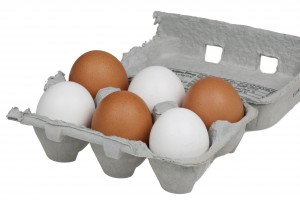 As the smell of a chicken farm accosted me from a few blocks away, I once again thought to myself “Hashgacha on raw eggs?
As the smell of a chicken farm accosted me from a few blocks away, I once again thought to myself “Hashgacha on raw eggs?
What could I possibly look for, other than a few ostriches ducking for cover?”
After determining there were no injections which would render the chickens and eggs a “Treif”, we proceeded to the egg processing area. Eggs can become soiled from the chicken feed. As a result, they require a three-step wash; the final one done with 120° water. Although there are opinions which do not consider this temperature to be Yad Soledes Bo, the OU is stringent (machmir).
This prompted an investigation into the chickens’ diet. Most chickens on the market are fed meat-derived substances. Indeed this was true for most of the 80,000 laying chickens on the farm I was inspecting. However, the chickens laying the eggs to be certified by the OU were in fact being fed grains. This was done in order to produce a better egg. “Is it possible the Yad Soledes wash causes the Chometz or Tarfus to be absorbed into the eggs?”, I thought to myself.
A second issue presented itself. After a flow of cold air cools the eggs off, they are sprayed with a coating of mineral oil. This spray acts as a sealer, closing up the eggs’ pores and extending their shelf life. “Could the spray, compromise the Kosher status of a hard boiled egg?”, I wondered. “Not to worry”, I told myself, “Mineral oil is a Group one (accepted from any source).” “But is the mineral oil blended with other oils?” “Are other such plants only using mineral oil?”
After several discussions with the eggsperts (sorry, I couldn’t help it), we have determined that the Yad Soledes wash does not cause the Issur or Chometz (before Pesach) to be of significant concern for a number of reasons, among which are the following: 1) It is unlikely that any residue of chicken feed remains after the first two rinses. 2) Even if a minute amount does remain, it will have become Nifgam from the cleansers used to clean and disinfect the eggs. Likewise, although a small amount of other oils are indeed added to mineral oil, it is definitely Botul. It is also the norm to use only mineral oil.
One consumer wanted to know if an OU certification on raw eggs means that they no longer have to check for blood spots. Good question. Before I answer, let me first explain the causes of blood spots.
Until recently, a blood spot in an egg would usually indicate the beginning of the creation of an embryo caused by a rooster’s fertilization. Although presently there are no roosters on most egg farms, blood spots can still occur as a result of hens becoming agitated (e.g. when there is thunder). When this takes place, blood vessels can rupture and cause a blood spot. When the hens are extremely agitated, such as during a severe thunderstorm, tissue from the hen’s ovary may actually break off, falling into the egg.
The USDA does require that the eggs be passed along a high-tech illuminating conveyer belt where a reddish color in an egg means that there is a blood or meat spot. Such eggs are immediately discarded. However, this test is not fool-proof. Thus the housewife must continue to check eggs for blood spots even when the eggs are certified by the OU.
Thank God, all’s well that ends well. All of our Kosher concerns regarding raw eggs turned out not to be of any Halachic significance. But it’s just another eggsample… never take anything for granted!

